A high level of lamb performance is achievable from grazed grass offered as the sole diet and is necessary to minimise costs of production.
However, many producers are unable to finish lambs from grazed grass alone. While the reasons for this inability are likely to include poor grassland management and parasite control, trace element (mineral) deficiency can be an issue in some sheep-producing areas in Ireland. It is known that the concentration of trace elements in pasture varies during the grazing season.
Trace element deficiencies can be inherent (low concentrations in the soil) or induced (uptake restricted by another trace element). Deficiencies may be expressed either in a clinical (symptoms present) or subclinical (no obvious symptoms) form.
However, subclinical deficiency may reduce lamb performance and thus can be economically important.
In Ireland, the main trace elements of concern include cobalt, selenium, copper and iodine. Cobalt deficiency is the most common.
The primary objective of this paper is to present information from a study undertaken at Athenry Research Farm on the effects of trace element supplementation on lamb performance post-weaning.
Lamb performance
Good grazing management will deliver high levels of lamb performance from grass post-weaning (Table 1).
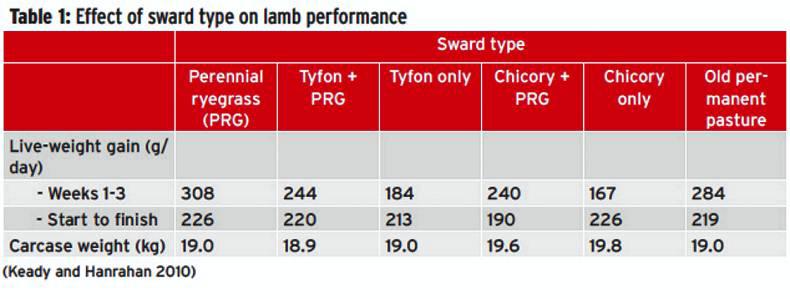
To achieve the best level of lamb performance from grazed grass, pasture must be managed to maximise the proportion of leaf in the sward canopy, thereby maintaining herbage digestibility and intake potential. This is achieved during the post-weaning period by grazing swards to a target post-grazing sward height of 6cm. However, when lambs are removed from the paddock, dry ewes can be used to graze the pastures down to 4 cm, thus ensuring a leafy re-growth for lambs on the next grazing rotation. If grazing after-grass, lambs can be let graze down to 5cm prior to moving.
There has been interest in the inclusion of alternative forages in grass seed mixtures sown in late May for grazing by lambs post-weaning. Results from a study at Athenry showed that neither tyfon nor chicory, offered as the sole forage or in combination with perennial ryegrass, had beneficial effects on lamb performance relative to a new perennial ryegrass reseed or to well-managed old permanent pasture.
Trace element study
A study was undertaken recently at the Athenry Research Centre to evaluate the effects on lamb performance post-weaning from supplementation with cobalt, either alone or in combination with vitamin B12 and selenium.
Selenium deficiency is associated with poor lamb performance and white muscle disease. Selenium is also important for immune function. Its metabolism is closely related to vitamin E, which acts as an antioxidant.
Cobalt is required by animals in the synthesis of vitamin B12 which is essential for the metabolism of a rumen volatile fatty acid (propionate) which is an important energy source to ruminants. Symptoms of deficiency include loss of condition, poor fleece quality, ears becoming dry and scaly (photosensitisation), loss of appetite, runny eyes with tear staining on the face, and higher worm counts (immune suppression).
The uptake of cobalt by plants from the soil can be restricted by high concentrations of manganese and by high soil pH. As cobalt is not stored in the body and is needed in the rumen, a continuous supply is required throughout the grazing season for vitamin B12 production. Vitamin B12 is absorbed from the small intestine and stored in the liver.
At weaning, lambs were divided into three groups and received either no supplementation or were supplemented with cobalt or a combination of cobalt, vitamin B12 and selenium. The lambs received their treatments, by drench, every 2 weeks. All lambs were grazed as one flock to remove any possible effects of grazing management on lamb performance. All lambs received the same anthelmintic treatments. The study commenced in mid-July and finished when the last lambs were drafted for slaughter in mid-December.
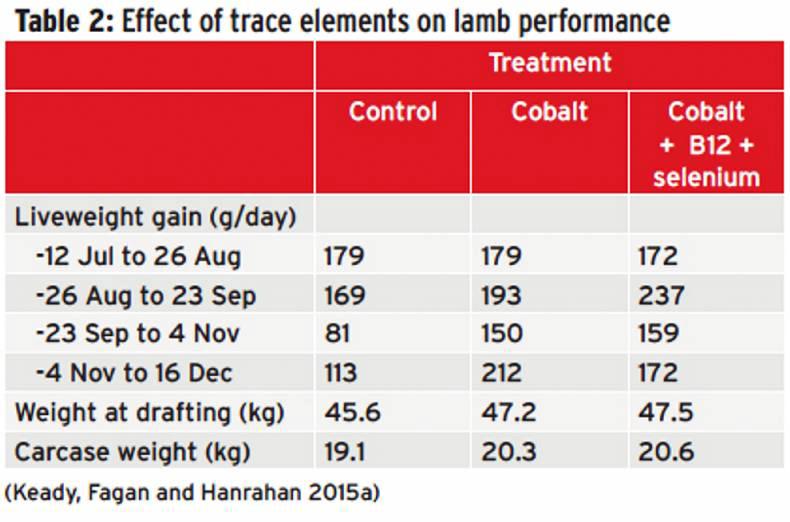
The effects of treatment on lamb performance are presented in Table 2. During the first 7 weeks of the study trace element supplementation had no effect on daily liveweight gain. However as the grazing season progressed supplementation with cobalt, offered either alone or in combination with vitamin B12 and selenium increased lamb weight gain. Consequently trace element supplementation increased lamb drafting weight and carcase weight by 1.75 kg and 1.35 kg, respectively. It is notable from these results that there was no benefit to including vitamin B12 and selenium with cobalt in the drench under conditions of the Athenry farm.
Blood samples were taken from the lambs that were drafted for slaughter on 4 November and 16 December and the results are presented in Table 3. This data shows that lambs on all treatments were in the normal range for blood copper, selenium and GSHPX (glutathione peroxide).
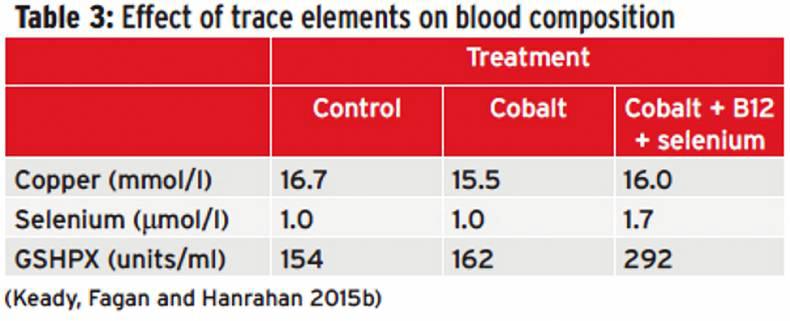
Furthermore, of all the lambs that were blood sampled only one lamb had blood copper concentrations (9.3 mmol/l) below the normal range ( 9.3 – 19 mmol/l) while 10% of lambs were above the normal range. Similarly, only 4 lambs had blood selenium concentrations below the normal range (0.75 – 3.0 µmol/l); the lowest was 0.61 µmol/l. However, including selenium in the trace element mixture increased blood selenium concentration.
Currently there is no accurate measure for blood cobalt concentration available in Ireland. As cobalt is stored in the liver in the form of vitamin B12, the best indicator for cobalt status is liver cobalt concentration. The effects of treatment on liver and kidney composition are presented in Table 4.
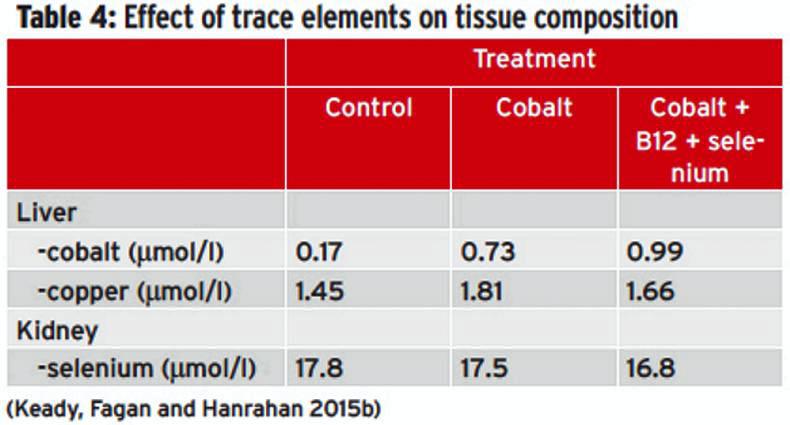
Lambs that did not receive any supplementation had a lower concentration of cobalt in the liver, being below the normal range. Supplementation with cobalt alone or in combination with vitamin B12 and selenium increased liver cobalt concentrations. Inclusion of vitamin B12 tended to increase liver cobalt concentration relative to the cobalt only treatment.
Kidney selenium levels were also measured. Including selenium in the drench had no effect on kidney selenium concentrations. Lambs which had been supplemented with cobalt alone or in combination with vitamin B12 and selenium had higher liver copper concentrations which may be due to higher herbage intakes.
This article was first published in July 2015.

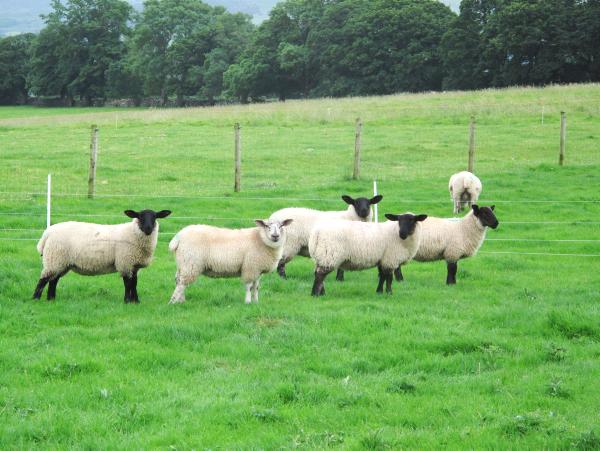




 This is a subscriber-only article
This is a subscriber-only article
















SHARING OPTIONS: